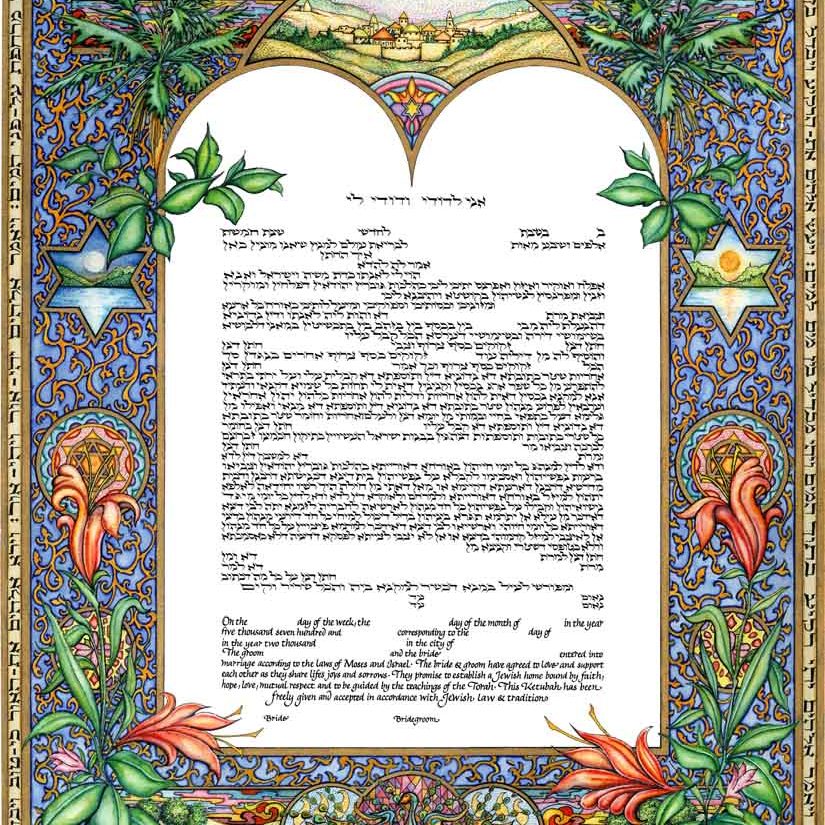
The Significance of a Ketubah
Howard Fox

THE ORIGINS OF THE KETUBAH
The traditional or historical ketubah is a binding legal document, one which catalogs a husband’s obligations to his wife, and makes provisions for her protection in the event of divorce or her husband’s death. It is a religious analogue to the contemporary pre-nuptial agreement of secular civil law.
Elements of the ketubah can be traced back to Biblical times. During that period, when a man consented to his daughter’s engagement he was thereby facing the impending departure of a contributing member of his household, and was viewed as requiring compensation for this loss. Thus, the groom’s family made a financial settlement - called a mohar - on the bride’s family as part of the engagement agreement. In addition, the groom would give wedding presents - mattan - to his bride. In the post-Biblical era, as economic conditions changed, the financial obligations to compensate a bride and her family at the time of marriage proved onerous, and made it difficult for young men without means to wed. Bride’s families began offering dowries to potential spouses in response. Moreover, the mohar was modified so that it was no longer a sum of money given directly to the bride’s father, but rather took the form of a mortgage or lien on the husband’s property, which he would be committed to paying out in the event of divorce, or which his estate would owe in the event of his death. The ketubah thus emerged as a way of documenting and certifying these arrangements, ensuring that a woman had a legal record of them for her own security. The ketubah, in short, assured women of their rights and recourses in the face of the loss of their marriage.
The earliest extant ketubah dates from circa 440 B.C.E. Found in Egypt and written on papyrus, this Aramaic document records the amount of the settlement the groom paid to the father of the bride, and also notes the amount each family contributed to the dowry. The ketubah names the wife as beneficiary in the case of the husband’s death.
The ketubah text was first formalized about three hundred years later, in the 1st century B.C.E., by the Sanhedrin (the presiding Judiac legislative body at the time); it’s authorship is attributed in the main to Rabbi Simeon ben Shetach. Despite undergoing several modifications since then, the ketubah text that has come down to us today closely resembles the one codified two thousand years ago. It is written in Aramaic, the language of legal and technical matters at the time, and an entire tractate of the Talmud is devoted to its intricacies.
The ketubah’s multiple sections record the particulars of the wedding (date, names of bride and groom, etc.) and enumerate the groom’s obligations - financial and conjugal - to his bride. Traditionally, the ketubah is not, as many people assume, a contract between husband and wife - neither, in fact, are required to sign the document. It is signed, rather, by two witnesses, who verify that the requisite conditions mentioned have been met by the groom. Another common misconception about the ketubah is that it in some way indicates that a man has purchased his wife, that it is some sort of transfer of property akin to a deed on a piece of land. This is not at all accurate - according to Jewish law there is no such relation of ownership between a husband and wife. The ketubah rather outlines the financial conditions that the groom must satisfy if the couple is to be permitted to undergo the wedding ceremony and become legally married.
what i Do
Intelligent, inspired projects reflective of the style, personality,
and values of our clients.
CUSTOMERS
PROJECTS
